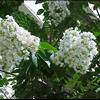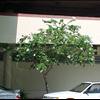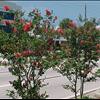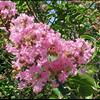This plant may be available to buy
Click the banana to see

|
Crape Myrtle click pics to enlarge |
|
Zones 6-9, poorly zone 10 Crape myrtle (correct name) is rated a deciduous shrub or a small tree. The plant is named crape or crepe because the flowers have crinkled petals which look like crepe paper Native to Asia, crape myrtle has been growing here since the 18th century so some folks think it is native American Crape myrtle can be seen from 10 feet to over 25 feet (some to near 40 feet) in a variety of colors. Some crape myrtles are rated dwarfs as small as 3-5 feet (may beLagerstroemia fauriei) and some may be as small as 18 inches Although some crape myrtle varieties are tolerant of zone 10, we observe that they are naked for all of the cooler months and into the spring. Definitely far from even sub-tropical status. However, you will enjoy blooming periods of 60-120 days during the hot summer months. Flowers are seen in spike-like clusters to about 8 inches long You may train your crape myrtle into a single trunk specimen, but natural are multi-trunked individuals with many ground level sprouts Large varieties grow quickly and may be upright or show a spreading habit. Crape myrtle seeds are abundant so plan on removing new plants sprouts every year Plant in full sun to light shade. Crape myrtle loves hot weather and is happy in dryer soils, but moist soil is fosters faster growth. Soil doesn't seen to be an issue Older varieties are subject to powdery mildew (a disfiguring fungus disease) and aphids. Newer hybrids are easier. Because there are so many variations, check with your favorite nurseryman to be sure you are getting the size, color and growth habit you want |










